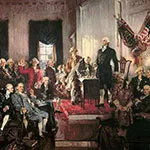U.S. Constitution – A Living Document
Discover How the U.S. Constitution Was Formed, How it Has Evolved and Why Only 27 Amendments Have Been Added in the Last Two Centuries
Students will follow inquiry-based learning to actively explore the process of writing and ratifying the U.S. Constitution, which established the structure and function of national government. They will also evaluate the significance of the Bill of Rights. This ground-breaking experiential learning curriculum is at your fingertips via web-based access. It includes all relevant research and sourced material needed to document facts. Students will:
- View a student-narrated video that traces the U.S. Constitution’s long road to ratification and the people and compromises involved in creating a living document which has been flexible enough to adapt over time.
- Identify the major arguments of the Federalists and Anti-Federalists in the debate over the U.S. Constitution and the Bill of Rights.
- Examine how the U.S. Constitution has evolved over the past two centuries as a result of its interpretation in seminal U.S. Supreme Court cases.
Illinois Constitution – Guiding Government in The Prairie State
Trace the Evolution of the Illinois Constitution and Discover Why Illinois Has Had Six Capitol Buildings
Students will follow inquiry-based learning to actively explore the events that led to the founding of Illinois, the adoption of the Illinois Constitution in 1818 and subsequent revisions to the document. This ground-breaking experiential learning curriculum is at your fingertips via web-based access. It includes all relevant research and sourced material needed to document facts. Students will:
- View a student-narrated video that describes how the Illinois Constitution was created and how and why it has changed over time.
- Compare the backgrounds of delegates to the U.S. Constitutional Convention at Philadelphia in 1787 with those of delegates to the Illinois Constitutional Convention at Kaskaskia in 1818.
- Evaluate the factors that contributed to the decision to move the Illinois state capital from Kaskaskia to Vandalia in 1819 and then to Springfield in the late 1830s.
How to Pass a Bill – Laws in the Making
Using Illinois As an Example, Take a Virtual Walk Inside the Illinois State Capitol to Understand Why It’s Important to Vote and See How Elected Officials Create Legislation that Impacts Us As Citizens
Students will follow inquiry-based learning to actively explore the roles played by the Illinois House of Representatives and the Illinois Senate in submitting ideas that get turned into laws. They’ll also examine how the Governor can approve (sign) or reject (veto) a bill, and why it’s important to vote. This ground-breaking experiential learning curriculum is at your fingertips via web-based access. It includes all relevant research and sourced material needed to document facts. Students will:
- View a student-narrated video that, with use of fun graphics, highlights the history of Illinois as a state, defines the roles of the legislative, executive and judicial branches, and breaks down the steps needed to pass legislation.
- Put together a plan to create a law to establish a holiday to celebrate Illinois becoming a state.
- Submit ideas on how to get involved with state government based on an investigation of how bills are passed in Illinois.
Bill of Rights, Ratification, and the Debate between Federalists and non Federalists
Unit Coming Soon
Landmark Supreme Court Decisions – The Constitutional Power
Unit Coming Soon







